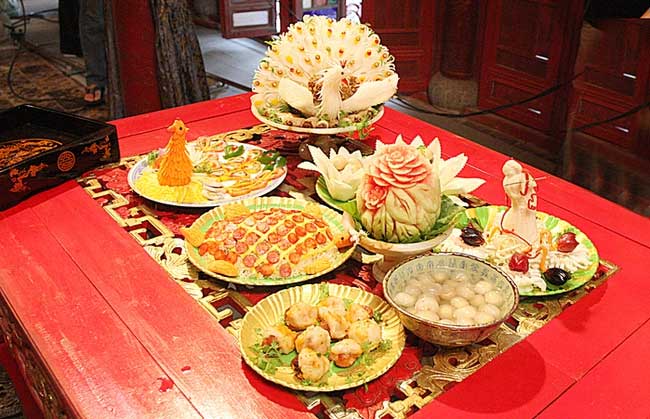Since ancient times, monarchs across various nations have established strict protocols to ensure safety when consuming exquisite delicacies. Historical records indicate that the Nguyen Dynasty rulers implemented detailed regulations regarding the preparation and serving of nutritious and safe meals.
Specifically, the Nguyen Dynasty established agencies known as Li Thien and Thuong Thien to serve meals for the king. Previously, during the Nguyen Lords’ era, the team responsible for cooking for the lords was called the Internal Kitchen or Tu Thien. In 1820, Emperor Minh Mang established the Thuong Thien team under the imperial guards and constructed the Thuong Thien facility near the Imperial Medical Institute.

Meals offered to Chinese emperors in ancient times underwent rigorous inspection and cooking processes.
The Thuong Thien team consisted of about 50 members. All ingredients used to prepare meals for the king had to be sourced from clear origins and were meticulously checked to ensure they were fresh, clean, and safe, free from harmful substances.
Even the drinking water used daily in the forbidden palace underwent testing to meet safety standards before being brought into the palace. Cooking exquisite meals for Vietnamese monarchs in ancient times had to adhere to strict cleanliness requirements, with no allowance for even a single hair or grain of sand to fall into the food. Any mistakes could result in punishment for the cooks, with the severity of the penalty depending on the nature of the error.
To prevent poisoning through food, monarchs used Kim Dao chopsticks for eating. The Nguyen emperors used bamboo chopsticks crafted by skilled artisans, but sometimes they would use chopsticks made from Kim Dao wood sourced from Bach Ma Mountain. The distinctive feature of Kim Dao chopsticks is their lightweight nature, ivory color, and the ability to change to a dark color upon contact with poison.
Not only Vietnamese monarchs but also ancient Chinese emperors had strict regulations regarding the preparation of clean food for their meals.
According to historical accounts, all food supplied to the imperial palace had to have clear origins and be carefully inspected. Typically, the ingredients used in dishes served to the emperor came from local specialties, while the palace also produced some food items and sourced others from various locations.
To prevent the Chinese emperor from being poisoned in his meals, a eunuch was responsible for tasting the dishes presented to the emperor to check for poison. This practice was known as “Thuong Thien.”
Additionally, the Chinese imperial palace used silver utensils such as bowls and chopsticks to test for poison. The reason for this is that silver changes from white to black upon contact with toxic substances.
Each dish served to the monarch came with a small sign indicating the name of the chef who prepared it. This practice allowed the monarchs to easily identify who cooked each dish, enabling quick identification of any culprits in case of an incident.


















































